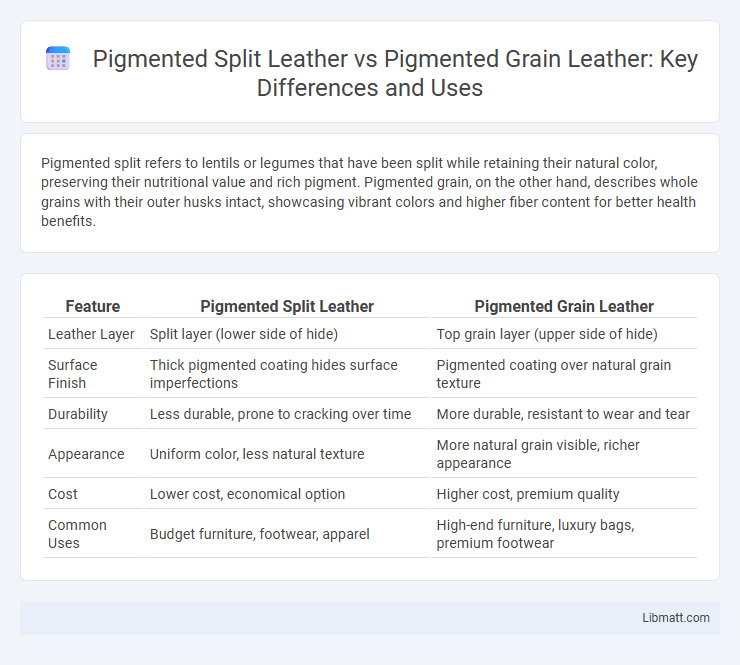Pigmented split refers to lentils or legumes that have been split while retaining their natural color, preserving their nutritional value and rich pigment. Pigmented grain, on the other hand, describes whole grains with their outer husks intact, showcasing vibrant colors and higher fiber content for better health benefits.
Table of Comparison
| Feature | Pigmented Split Leather | Pigmented Grain Leather |
|---|---|---|
| Leather Layer | Split layer (lower side of hide) | Top grain layer (upper side of hide) |
| Surface Finish | Thick pigmented coating hides surface imperfections | Pigmented coating over natural grain texture |
| Durability | Less durable, prone to cracking over time | More durable, resistant to wear and tear |
| Appearance | Uniform color, less natural texture | More natural grain visible, richer appearance |
| Cost | Lower cost, economical option | Higher cost, premium quality |
| Common Uses | Budget furniture, footwear, apparel | High-end furniture, luxury bags, premium footwear |
Introduction to Pigmented Leather: Split vs Grain
Pigmented leather is coated with a pigmented layer that enhances durability and color consistency, commonly available in split and grain types. Pigmented split leather originates from the lower layers of the hide, offering a more affordable option with a smooth surface but less natural texture than grain. Your choice between pigmented split and grain leather depends on the desired balance between cost, appearance, and surface durability.
Understanding Pigmentation in Leather
Pigmented split leather features a coarse surface coated with a pigmented layer that enhances color uniformity and durability. Pigmented grain leather retains the natural grain texture beneath the pigmented topcoat, preserving the leather's authentic appearance while offering color protection. Understanding these differences helps you choose the right leather finish for your products based on both aesthetic and functional needs.
What is Pigmented Split Leather?
Pigmented split leather is made from the fibrous lower layer of the hide that is coated with a pigmented finish to enhance durability and provide uniform color. This type of leather often mimics the appearance of full-grain leather but is less expensive due to its use of split hides. The pigmented coating improves resistance to stains and wear, making it popular for furniture, automotive upholstery, and fashion accessories.
What is Pigmented Grain Leather?
Pigmented grain leather is a type of leather coated with a pigmented layer that enhances durability and provides a uniform color and finish, making it resistant to stains and wear. This leather is typically more affordable and easier to maintain compared to aniline or semi-aniline leathers, as the pigment layer conceals natural imperfections. For your furniture or accessories, choosing pigmented grain leather ensures a consistent appearance and long-lasting protection against everyday use.
Key Differences: Pigmented Split vs Pigmented Grain
Pigmented splits are dehulled, processed forms of pigmented grains with reduced fiber content, typically used for easier cooking and digestion. Pigmented grains retain their outer bran layer, preserving higher fiber, antioxidants, and nutritional value compared to their split counterparts. The key differences lie in texture, cooking time, and nutrient concentration, with pigmented grains offering a more fibrous, nutrient-dense option while pigmented splits provide convenience and quicker preparation.
Appearance and Texture Comparison
Pigmented split lentils have a smooth, flat surface with a matte finish and a slightly softer texture when cooked, offering a creamy mouthfeel. Pigmented grains retain their outer husk, showcasing a glossy, rounded appearance with a firmer, chewier texture after cooking. Your choice depends on whether you prefer a delicate, softer consistency or a robust, chewy bite in pigmented legumes.
Durability and Performance Factors
Pigmented split materials generally exhibit higher durability due to their thicker, more robust surface layers that resist wear and abrasion better than pigmented grain. Pigmented grain, while offering a smoother and more uniform appearance, tends to be less resistant to scratches and environmental damage, impacting long-term performance. Factors such as pigment penetration depth and leather finishing processes critically influence the endurance and aesthetic retention of both pigmented split and pigmented grain leathers.
Common Uses and Applications
Pigmented split and pigmented grain are commonly used in various culinary applications, with pigmented grain often preferred for whole-grain dishes, porridges, and baking due to its intact bran and nutritional benefits. Pigmented split is favored in soups, stews, and pastes where quicker cooking times and smooth textures are desired, making it suitable for efficient meal preparation. Your choice between these forms depends on the desired texture and preparation speed in your recipes.
Maintenance and Care Tips
Pigmented split and pigmented grain leather both require specific maintenance to preserve their color and texture, with pigmented split demanding more frequent cleaning due to its open fiber structure. Use a soft brush or vacuum to remove dirt from pigmented split leather, while pigmented grain leather benefits from wiping with a damp cloth and applying a quality leather conditioner to maintain its protective finish. Your regular care routine should avoid harsh chemicals and include conditioning every 3-6 months to prolong the lifespan and vibrant appearance of both types.
Choosing the Right Pigmented Leather for Your Needs
Pigmented split leather offers durability and affordability with a consistent pigmented coating that masks natural imperfections, making it ideal for items requiring a uniform appearance. Pigmented grain leather, however, retains the natural grain pattern beneath the pigment layer, providing a more authentic look and enhanced resistance to wear and staining. Choosing the right pigmented leather depends on your need for either aesthetic naturalness with durability or cost-effective uniformity in your leather products.
Pigmented split vs pigmented grain Infographic

 libmatt.com
libmatt.com